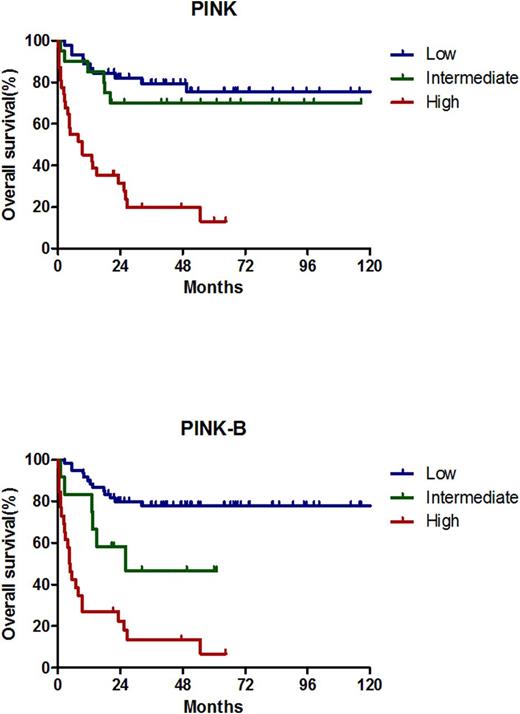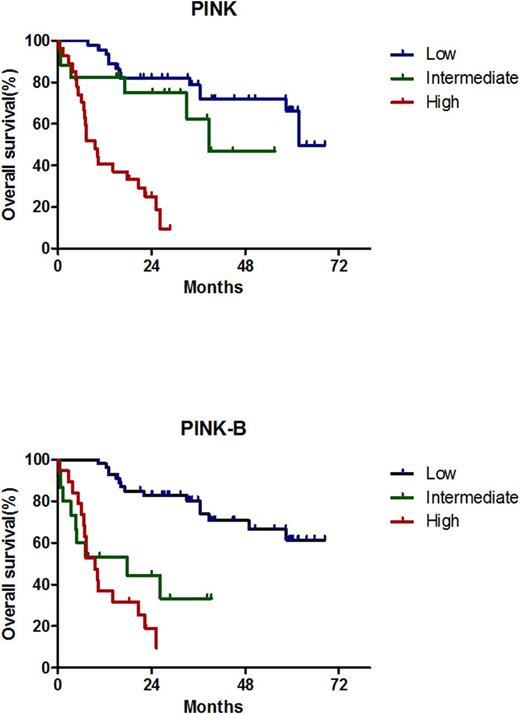Abstract
Background
Novel treatment strategies, such as non-anthracycline-based chemotherapy and upfront use of concurrent chemoradiotherapy or radiotherapy have markedly improved the survival outcome of extranodal natural killer/T cell lymphoma (ENKTL). Recently, a new prognostic model, Prognostic Index of Natural killer cell lymphoma (PINK) was proposed for predicting clinical outcomes of ENKTL patients treated with non-anthracycline-based strategies. Elevated serum beta-2 microglobulin (B2M) had been suggested as a potential prognostic predictor for patients with ENKTL, but there was no prognostic model including serum B2M level. We investigated the prognostic role of serum B2M level and suggested a new prognostic index by incorporating serum B2M level into PINK in patients with ENKTL.
Methods
We retrospectively identified 98 patients who received non-anthracycline-based treatment for newly diagnosed ENKTL in Asan Medical Center between January 2005 to December 2014. Serum beta-2 microglobulin level was measured using a radioimmunoassay kit (Immunotech, Inc., Prague, Czech Republic). The optimal cutoff point of serum beta-2 microglobulin level was estimated using ROC curve analysis. We developed a new prognostic model (PINK-B) with 4 elements of PINK (Age>60 years, Ann arabor Stage ¥²-¥³, distant lymph node involvement, and non-nasal type disease) plus serum B2MG level. We performed a validation analysis of a new prognostic model (PINK-B) in an independent cohort.
Result
Baseline characteristic were summarized in Table 1. Median B2M value was 2.35 mg/L (range, 1.0-22.0) and the optimal cutoff value of serum B2M level for predicting 3-year overall survival (OS) was ¡Ã2.8 mg/L. Baseline serum B2M elevation (¡Ã2.8 mg/L) was observed in 39 patients (39.8%). In univariate analysis, elevated B2M level (¡Ã2.8 mg/L) was significantly associated with poorer OS (HR=3.83 ;95% CI: 2.06-7.09; p<0.001). We performed multivariate analysis including 4 factors of PINK and elevated serum B2M level. In the multivariate analysis, elevated serum B2M level retained its significant poor prognostic impact for OS (HR=2.13 ;95% CI: 1.09-4.17; p=0.028). Three risk groups in PINK-B were composed as followings: low risk (0-1 points), intermediate risk (2-3 points), and high risk (4 or more points). PINK-B showed better discriminative power compared with PINK for predicting 3-year OS of low-, intermediate-, and high-risk group: 79.5%, 70.0%, and 18.6% for PINK, 78.3%, 40.9%, and 13.5% for PINK-B, respectively. (Figure 1.) The C-indices for PINK and PINK-B were 0.72 (95% CI: 0.62-0.82) and 0.74 (95% CI: 0.64-0.84). We applied PINK and PINK-B to an independent cohort of 90 newly diagnosed ENKTL patients. The performance of PINK and PINK-B for predicting probabilities was validated and 3-years OS of low-, intermediate-, and high-risk groups were 80.2%, 68.7%, and 9.4% for PINK and 80.3%, 31.3%, and 9.5% for PINK-B, respectively (Figure 2.)
Conclusion
We suggest a new version of prognostic index (PINK-B : PINK combined with elevated serum B2M) for ENKTL patients treated with non-anthracycline-based strategies.
Comparison of baseline characteristics between the training cohort and validation cohort
Comparison of baseline characteristics between the training cohort and validation cohort
overall survival according to PINK, PINK-E, PINK-B in the training cohort
overall survival according to PINK, PINK-E, PINK-B in the validation cohort
Kim:Celltrion, Inc.: Consultancy, Honoraria.
Author notes
Asterisk with author names denotes non-ASH members.




This feature is available to Subscribers Only
Sign In or Create an Account Close Modal